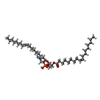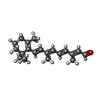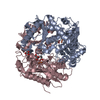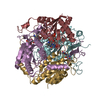+ データを開く
データを開く
- 基本情報
基本情報
| 登録情報 | データベース: EMDB / ID: EMD-25079 | |||||||||
|---|---|---|---|---|---|---|---|---|---|---|
| タイトル | ChRmine in MSP1E3D1 lipid nanodisc | |||||||||
 マップデータ マップデータ | ChRmine in MSP1E3D1 lipid nanodisc | |||||||||
 試料 試料 |
| |||||||||
| 生物種 |  Tiarina fusa (真核生物) / Tiarina fusa (真核生物) /  Rhodomonas lens (真核生物) Rhodomonas lens (真核生物) | |||||||||
| 手法 | 単粒子再構成法 / クライオ電子顕微鏡法 / 解像度: 2.74 Å | |||||||||
 データ登録者 データ登録者 | Tucker K / Brohawn S | |||||||||
| 資金援助 |  米国, 1件 米国, 1件
| |||||||||
 引用 引用 |  ジャーナル: Nat Commun / 年: 2022 ジャーナル: Nat Commun / 年: 2022タイトル: Cryo-EM structures of the channelrhodopsin ChRmine in lipid nanodiscs. 著者: Kyle Tucker / Savitha Sridharan / Hillel Adesnik / Stephen G Brohawn /  要旨: Microbial channelrhodopsins are light-gated ion channels widely used for optogenetic manipulation of neuronal activity. ChRmine is a bacteriorhodopsin-like cation channelrhodopsin (BCCR) more closely ...Microbial channelrhodopsins are light-gated ion channels widely used for optogenetic manipulation of neuronal activity. ChRmine is a bacteriorhodopsin-like cation channelrhodopsin (BCCR) more closely related to ion pump rhodopsins than other channelrhodopsins. ChRmine displays unique properties favorable for optogenetics including high light sensitivity, a broad, red-shifted activation spectrum, cation selectivity, and large photocurrents, while its slow closing kinetics impedes some applications. The structural basis for ChRmine function, or that of any other BCCR, is unknown. Here, we present cryo-EM structures of ChRmine in lipid nanodiscs in apo (opsin) and retinal-bound (rhodopsin) forms. The structures reveal an unprecedented trimeric architecture with a lipid filled central pore. Large electronegative cavities on either side of the membrane facilitate high conductance and selectivity for cations over protons. The retinal binding pocket structure suggests channel properties could be tuned with mutations and we identify ChRmine variants with ten-fold decreased and two-fold increased closing rates. A T119A mutant shows favorable properties relative to wild-type and previously reported ChRmine variants for optogenetics. These results provide insight into structural features that generate an ultra-potent microbial opsin and provide a platform for rational engineering of channelrhodopsins with improved properties that could expand the scale, depth, and precision of optogenetic experiments. | |||||||||
| 履歴 |
|
- 構造の表示
構造の表示
| ムービー |
 ムービービューア ムービービューア |
|---|---|
| 構造ビューア | EMマップ:  SurfView SurfView Molmil Molmil Jmol/JSmol Jmol/JSmol |
| 添付画像 |
- ダウンロードとリンク
ダウンロードとリンク
-EMDBアーカイブ
| マップデータ |  emd_25079.map.gz emd_25079.map.gz | 38.3 MB |  EMDBマップデータ形式 EMDBマップデータ形式 | |
|---|---|---|---|---|
| ヘッダ (付随情報) |  emd-25079-v30.xml emd-25079-v30.xml emd-25079.xml emd-25079.xml | 12.2 KB 12.2 KB | 表示 表示 |  EMDBヘッダ EMDBヘッダ |
| 画像 |  emd_25079.png emd_25079.png | 189.3 KB | ||
| アーカイブディレクトリ |  http://ftp.pdbj.org/pub/emdb/structures/EMD-25079 http://ftp.pdbj.org/pub/emdb/structures/EMD-25079 ftp://ftp.pdbj.org/pub/emdb/structures/EMD-25079 ftp://ftp.pdbj.org/pub/emdb/structures/EMD-25079 | HTTPS FTP |
-検証レポート
| 文書・要旨 |  emd_25079_validation.pdf.gz emd_25079_validation.pdf.gz | 429.5 KB | 表示 |  EMDB検証レポート EMDB検証レポート |
|---|---|---|---|---|
| 文書・詳細版 |  emd_25079_full_validation.pdf.gz emd_25079_full_validation.pdf.gz | 429.1 KB | 表示 | |
| XML形式データ |  emd_25079_validation.xml.gz emd_25079_validation.xml.gz | 6.1 KB | 表示 | |
| CIF形式データ |  emd_25079_validation.cif.gz emd_25079_validation.cif.gz | 7 KB | 表示 | |
| アーカイブディレクトリ |  https://ftp.pdbj.org/pub/emdb/validation_reports/EMD-25079 https://ftp.pdbj.org/pub/emdb/validation_reports/EMD-25079 ftp://ftp.pdbj.org/pub/emdb/validation_reports/EMD-25079 ftp://ftp.pdbj.org/pub/emdb/validation_reports/EMD-25079 | HTTPS FTP |
-関連構造データ
- リンク
リンク
| EMDBのページ |  EMDB (EBI/PDBe) / EMDB (EBI/PDBe) /  EMDataResource EMDataResource |
|---|
- マップ
マップ
| ファイル |  ダウンロード / ファイル: emd_25079.map.gz / 形式: CCP4 / 大きさ: 40.6 MB / タイプ: IMAGE STORED AS FLOATING POINT NUMBER (4 BYTES) ダウンロード / ファイル: emd_25079.map.gz / 形式: CCP4 / 大きさ: 40.6 MB / タイプ: IMAGE STORED AS FLOATING POINT NUMBER (4 BYTES) | ||||||||||||||||||||||||||||||||||||||||||||||||||||||||||||||||||||
|---|---|---|---|---|---|---|---|---|---|---|---|---|---|---|---|---|---|---|---|---|---|---|---|---|---|---|---|---|---|---|---|---|---|---|---|---|---|---|---|---|---|---|---|---|---|---|---|---|---|---|---|---|---|---|---|---|---|---|---|---|---|---|---|---|---|---|---|---|---|
| 注釈 | ChRmine in MSP1E3D1 lipid nanodisc | ||||||||||||||||||||||||||||||||||||||||||||||||||||||||||||||||||||
| 投影像・断面図 | 画像のコントロール
画像は Spider により作成 | ||||||||||||||||||||||||||||||||||||||||||||||||||||||||||||||||||||
| ボクセルのサイズ | X=Y=Z: 1.137 Å | ||||||||||||||||||||||||||||||||||||||||||||||||||||||||||||||||||||
| 密度 |
| ||||||||||||||||||||||||||||||||||||||||||||||||||||||||||||||||||||
| 対称性 | 空間群: 1 | ||||||||||||||||||||||||||||||||||||||||||||||||||||||||||||||||||||
| 詳細 | EMDB XML:
CCP4マップ ヘッダ情報:
| ||||||||||||||||||||||||||||||||||||||||||||||||||||||||||||||||||||
-添付データ
- 試料の構成要素
試料の構成要素
-全体 : ChRmine trimer
| 全体 | 名称: ChRmine trimer |
|---|---|
| 要素 |
|
-超分子 #1: ChRmine trimer
| 超分子 | 名称: ChRmine trimer / タイプ: complex / ID: 1 / 親要素: 0 / 含まれる分子: #1 |
|---|---|
| 由来(天然) | 生物種:  Tiarina fusa (真核生物) Tiarina fusa (真核生物) |
| 組換発現 | 生物種:  |
| 分子量 | 理論値: 110 KDa |
-分子 #1: ChRmine
| 分子 | 名称: ChRmine / タイプ: protein_or_peptide / ID: 1 / コピー数: 3 / 光学異性体: LEVO |
|---|---|
| 由来(天然) | 生物種:  Rhodomonas lens (真核生物) Rhodomonas lens (真核生物) |
| 分子量 | 理論値: 36.602957 KDa |
| 組換発現 | 生物種:  |
| 配列 | 文字列: M(AYA)HAPGTDQM FYVGTMDGWY LDTKLNSVAI GAHWSCFIVL TITTFYLGYE SWTSRGPSKR TSFYAGYQEE QNLALF VNF FAMLSYFGKI VADTLGHNFG DVGPFIIGFG NYRYADYMLT CPMLVYDLLY QLRAPYRVSC SAIIFAILMS GVLAEFY AE ...文字列: M(AYA)HAPGTDQM FYVGTMDGWY LDTKLNSVAI GAHWSCFIVL TITTFYLGYE SWTSRGPSKR TSFYAGYQEE QNLALF VNF FAMLSYFGKI VADTLGHNFG DVGPFIIGFG NYRYADYMLT CPMLVYDLLY QLRAPYRVSC SAIIFAILMS GVLAEFY AE GDPRLRNGAY AWYGFGCFWF IFAYSIVMSI VAKQYSRLAQ LAQDTGAEHS LHVLKFAVFT FSMLWILFPL VWAICPRG F GWIDDNWTEV AHCVCDIVAK SCYGFALARF RKTYDEELFR LLEQLGHDED EFQKLELDMR LSSNGERLRR LSLNSLEVL FQ |
-分子 #2: 1,2-dioleoyl-sn-glycero-3-phosphoethanolamine
| 分子 | 名称: 1,2-dioleoyl-sn-glycero-3-phosphoethanolamine / タイプ: ligand / ID: 2 / コピー数: 21 / 式: PEE |
|---|---|
| 分子量 | 理論値: 744.034 Da |
| Chemical component information |  ChemComp-PEE: |
-分子 #3: RETINAL
| 分子 | 名称: RETINAL / タイプ: ligand / ID: 3 / コピー数: 3 / 式: RET |
|---|---|
| 分子量 | 理論値: 284.436 Da |
| Chemical component information |  ChemComp-RET: |
-分子 #4: water
| 分子 | 名称: water / タイプ: ligand / ID: 4 / コピー数: 3 / 式: HOH |
|---|---|
| 分子量 | 理論値: 18.015 Da |
| Chemical component information |  ChemComp-HOH: |
-実験情報
-構造解析
| 手法 | クライオ電子顕微鏡法 |
|---|---|
 解析 解析 | 単粒子再構成法 |
| 試料の集合状態 | particle |
- 試料調製
試料調製
| 濃度 | 14.4 mg/mL | |||||||||
|---|---|---|---|---|---|---|---|---|---|---|
| 緩衝液 | pH: 7.5 構成要素:
| |||||||||
| グリッド | モデル: Quantifoil R1.2/1.3 / 材質: GOLD / メッシュ: 300 / 支持フィルム - 材質: CARBON / 支持フィルム - トポロジー: HOLEY / 前処理 - タイプ: GLOW DISCHARGE | |||||||||
| 凍結 | 凍結剤: ETHANE / チャンバー内湿度: 100 % / チャンバー内温度: 277 K / 装置: FEI VITROBOT MARK IV |
- 電子顕微鏡法
電子顕微鏡法
| 顕微鏡 | TFS TALOS |
|---|---|
| 撮影 | フィルム・検出器のモデル: GATAN K3 (6k x 4k) / 平均電子線量: 50.0 e/Å2 |
| 電子線 | 加速電圧: 200 kV / 電子線源:  FIELD EMISSION GUN FIELD EMISSION GUN |
| 電子光学系 | 照射モード: FLOOD BEAM / 撮影モード: BRIGHT FIELD |
 ムービー
ムービー コントローラー
コントローラー
















 Z (Sec.)
Z (Sec.) Y (Row.)
Y (Row.) X (Col.)
X (Col.)





















